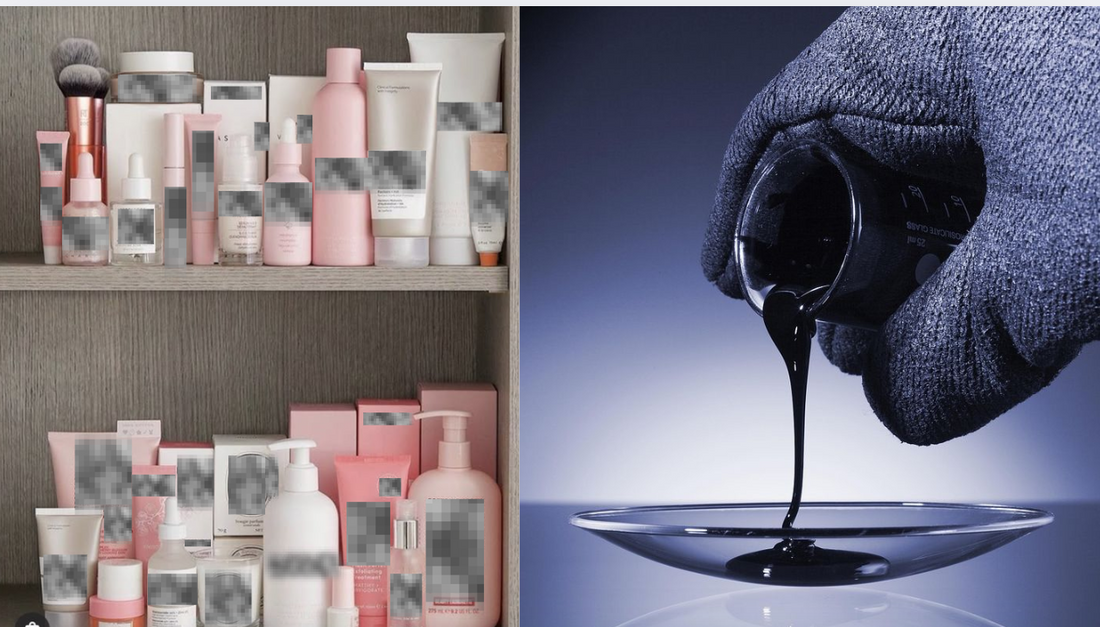Have you ever wondered what’s really in your favorite creams, lip balms and serums?
Many cosmetic products, even those that seem harmless, contain petroleum-derived ingredients that could pose long-term health risks. We’re talking about Mineral Oil Saturated Hydrocarbons (MOSH) and Mineral Oil Aromatic Hydrocarbons (MOAH).
What are MOSH and MOAH?
- MOSH (Mineral Oil Saturated Hydrocarbons) are petroleum-based substances that, after repeated use of cosmetic products, can accumulate in the human body, particularly in fatty tissue.
- Even more concerning is the presence of MOAH (Mineral Oil Aromatic Hydrocarbons), a fraction that may include genotoxic and potentially carcinogenic compounds, such as Polycyclic Aromatic Hydrocarbons (PAHs).
The study, “Evaluation of mineral oil saturated hydrocarbons (MOSH) and mineral oil aromatic hydrocarbons (MOAH) in pure mineral hydrocarbon-based cosmetics and cosmetic raw materials using ¹H NMR spectroscopy,” conducted by researchers from the CVUA Karlsruhe Institute and the Karlsruhe Institute of Technology (KIT), revealed that these compounds are present in everyday cosmetics such as petroleum jelly, lip balms, and creams. The most alarming finding: some of these substances have been detected in breast milk, indicating significant bioaccumulation.
¿Why didn’t you know?
Big brands usually don’t disclose these ingredients because they are legally allowed in certain concentrations, and their names can be hidden under terms like “paraffinum liquidum,” “petrolatum,” or simply “mineral oil.” Additionally, traditional analysis methods (such as LC-GC-FID) might overestimate or underestimate the actual MOAH content, creating uncertainty in the data that is reported.
A revealing study: NMR.
Thanks to nuclear magnetic resonance (NMR) technology, the study was able to analyze 27 cosmetic products and found MOAH levels ranging from 0.01 g/100g to 1.10 g/100g. Although these values seem low, there is no clear consensus on what constitutes a safe level, especially considering that many of these substances could be avoidable.
The most striking finding: mineral oil-based cosmetic products are composed almost exclusively of MOSH, with variable traces of MOAH, which are not always detected by conventional methods.
What can you do as a conscious consumer?
- Read labels: avoid products containing “paraffinum liquidum,” “petrolatum,” or “mineral oil.”
- Choose transparent brands that use certified natural ingredients.
- Support science: demand updated studies and reliable analytical methods like NMR from brands.
Less marketing. More truth.
Big cosmetic brands rarely tell you that part of what you apply to your skin may be related to petroleum residues. At Olively, we are committed to clean, safe, and honest ingredients. Because your well-being shouldn’t be wrapped in confusing labels.
Know what you put on your skin and feel the peace of mind that comes with choosing consciously: https://olively.store/collections/all
Reference:
Lachenmeier, D. W., Mildau, G., Rullmann, A., Marx, G., Walch, S. G., Hartwig, A., & Kuballa, T. (2017). Evaluation of mineral oil saturated hydrocarbons (MOSH) and mineral oil aromatic hydrocarbons (MOAH) in pure mineral hydrocarbon‑based cosmetics and cosmetic raw materials using¹H NMR spectroscopy. F1000Research, 6, 682. https://doi.org/10.12688/f1000research.11534.2

